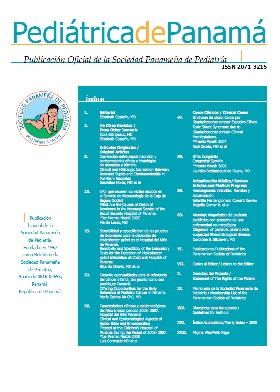Efecto de la nutrición enteral continua vs intermitente en la evolución clínica de lactantes en estado crítico
DOI:
https://doi.org/10.37980/im.journal.rspp.20171666Resumen
Introducción: La nutrición enteral (NE) en un paciente críticamente enfermo es un tema controversial debido a su amplia variabilidad entre las Unidades de Terapia Intensiva (UTI) en el tiempo de inicio, la ruta y la forma de administración y los algoritmos de decisión de acuerdo a la evolución del paciente. Se han realizado estudios que comparan la administración continua e intermitente a través de la medición de complicaciones y logro de metas establecidas, pero rara vez se han encontrado diferencias significativas. Pocos estudios se han realizado en niños.Métodos: Se realizó un estudio observacional, analítico, de cohorte con controles históricos en lactantes atendidos en la UTI 1 del Hospital del Niño Dr. José Renán Esquivel, comparando una cohorte del año 2016, quienes recibieron nutrición enteral continua durante el tiempo de ventilación mecánica invasiva (casos, n=98), con una del año 2012, quienes recibieron nutrición enteral intermitente (controles, n=90).Resultados: Las características epidemiológicas fueron similares en ambos grupos, a excepción de la media de edad, que fue mayor en los casos (7.9 vs 5.4 meses, p=0.00), y la media de tiempo en iniciar la NE, que fue menor en los casos que en los controles (14.2 vs 19.2 horas, p=0.00). Se demostró que la NE continua aumenta la probabilidad de alcanzar el 75% de la meta calórica 1.7 veces (IC=1.3-2.2). En el grupo que recibió infusión continua, los pacientes que alcanzaron el 75% y 100% de las metas calóricas lo hicieron más rápido que en el grupo control, p=0.00 y 0.02, respectivamente. No se encontró asociación entre la modalidad de NE y el desarrollo de infecciones asociadas a cuidados de la salud (IACS), el tiempo de ventilación mecánica, el tiempo de estancia en UTI y la mortalidad.Conclusiones: La utilización de nutrición enteral continua aumenta la probabilidad de alcanzar el 75% de la meta calórica para el paciente y permite alcanzar el 75% y 100% de la meta calórica más rápido. El desarrollo de IACS, el tiempo de ventilación mecánica, el tiempo de estancia en UTI y la mortalidad fueron similares en ambos grupos.Publicado
Número
Sección
Licencia
Derechos de autor 2020 Infomedic InternationalDerechos autoriales y de reproducibilidad. La Revista Pediátrica de Panamá es un ente académico, sin fines de lucro, que forma parte de la Sociedad Panameña de Pediatría. Sus publicaciones son de tipo gratuito, para uso individual y académico. El autor, al publicar en la Revista otorga sus derechos permanente para que su contenido sea editado por la Sociedad y distribuido Infomedic International bajo la Licencia de uso de distribución. Las polítcas de distribución dependerán del tipo de envío seleccionado por el autor.





 Suscripción a Novedades
Suscripción a Novedades